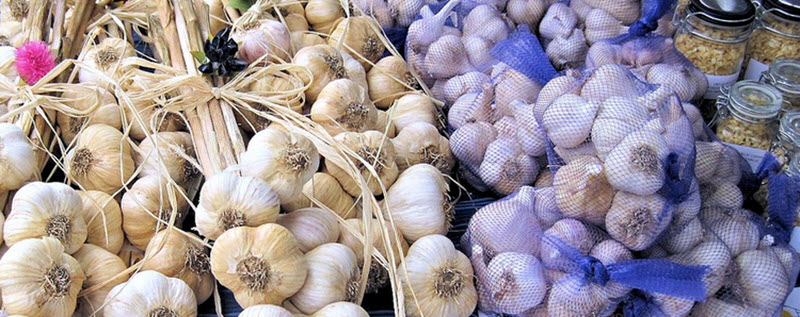Contents

Garlic (Allium sativum) belongs to the same family as leeks, chives, onions and shallots. The fragant garlic has a long history of being used both for food and for its alleged medical properties. Sankrit records from 5,000 years ago includes references to the use of garlic remedies.
During both World War I and World War II, garlic was used as an antiseptic to prevent gangrene in wounds. During WWI, it was also used to combat the dysentery that spread due to poor sanitary conditions in the trenches and impure water collected from shell-holes or other cavities.
| Scientific classification | |
| Kingdom: | Plantae |
| Clade: | Angiosperms |
| Clade: | Monocots |
| Order: | Asparagales |
| Family: | Amaryllidaceae |
| Subfamily: | Allioideae |
| Genus: | Allium |
| Species: | Allium sativum |
| Binomial name | |
| Allium sativum | |
USDA nutrient profile
A typical serving of one or a few cloves will not provide you with any significant amounts of carbohydrates, fat, protein, vitamins or minerals. The table below is for 100 gram of garlic, and it is unusual to eat that much in one sitting.
| Nutritional value per 100 g of raw garlic | |
| Energy | 149 kcal |
| Carbohydrates | 33.06 g |
| Sugars | 1 g |
| Dietary fiber | 2.1 g |
| Fat | 0.5 g |
| Protein | 6.36 g |
| Vitamins | |
| Thiamine (B1) | (17%)
0.2 mg |
| Riboflavin (B2) | (9%)
0.11 mg |
| Niacin (B3) | (5%)
0.7 mg |
| Pantothenic acid (B5) | (12%)
0.596 mg |
| Vitamin B6 | (95%)
1.235 mg |
| Folate (B9) | (1%)
3 μg |
| Vitamin C | (38%)
31.2 mg |
| Minerals | |
| Calcium | (18%)
181 mg |
| Iron | (13%)
1.7 mg |
| Magnesium | (7%)
25 mg |
| Manganese | (80%)
1.672 mg |
| Phosphorus | (22%)
153 mg |
| Potassium | (9%)
401 mg |
| Sodium | (1%)
17 mg |
| Zinc | (12%)
1.16 mg |
| Other constituents | |
| Selenium | 14.2 μg |
| Percentages are roughly approximated using US recommendations for adults. | |
Source: http://ndb.nal.usda.gov/ndb/search/list?qlookup=11215&format=Full
Allicin
Many of the alleged health-promoting effects of garlic is believed to be due to allicin. Allicin is the sulphur-containing compound that gives garlic its distinctive taste and odor. The plant produces this compound as a defense against attacks. When fresh garlic is chopped or crushed, the enzyme alliinase converts alliin into allicin.
In laboratory studies, allicin has displayed numerous antimicrobial properties. It is currently being investigated as a potential weapon against methicillin-resistant Staphylococcus aureus (MRSA), since previous studies have yielded promising results, even for strains of MRSA that are resistant to may other commonly utilized chemical agents.
Garlic and cardiovascular health
A 2007 meta-analysis showed that garlic preparations are superior to placebo in reducing blood pressure in individuals with hypertension. This is due to garlics ability to widen blood vessels.
A 2013 meta-analysis showed that garlic can lower total cholesterol in adults with high cholesterol if taken for longer than two months.

Garlic and cancer
A 2014 meta-analysis of studies carried out in Korea showed that garlic consumption was associated with a lower risk of stomach cancer.
Garlic as an anticoagulant
Garlic can reduce platelet aggregation. If you are using an anticoagulant drug, you should keep your garlic intake low.
Of course, there are situations where garlic’s ability to reduce platelet aggregation would be desirable. Reduced platelet aggregation means that blood clots are less likely to form. It is therefore possible that a diet rich in garlic could reduce the risk of heart attacks and other serious blood clots.
Eating garlic
Quick and easy recipe for yogurt garlic sauce
- Chop 3 cloves of garlic. Place the garlic in a mortar together with ½ teaspoon of coarse salt. Use the pestle to mash salt and garlic into a paste.
- Put the mash in a bowl. Add 1 cup of Greek yogurt and 1 tablespoon of lemon juice.
- Stir ingredients together and store refrigerated.
Examples of garlic with Protected Geographical Status within the European Union
- Aglio Rosso di Nubia from Nubia-Paceco, Provincia di Trapani, Sicily, Italy
- Aglio Bianco Polesano from Veneto, Italy
- Aglio di Voghiera from Ferrara, Emilia-Romagna, Italy
- Ail blanc de Lomagne from Lomagne, Gascony, France
- Ail de la Drôme from Drôme, France
- Ail rose de Lautrec from Lautrec, France
- Ajo Morado de las Pedroñeras from Las Pedroñeras, Spain
Other members of the Allium genus in the UK
In the United Kingdom, you can find at least three Allium species in the wild:
- Wild garlic (Allium ursinum)
- Crow garlic (Allium vineale )
- Field garlic ( Allium oleraceum)
In North America, the names Wild garlic and Crow garlic typically refers to Allium vineale instead.

